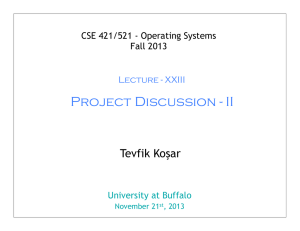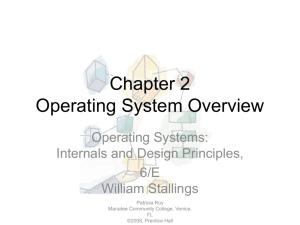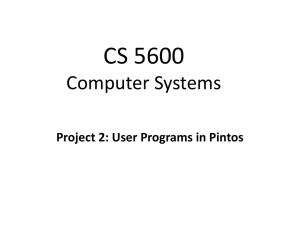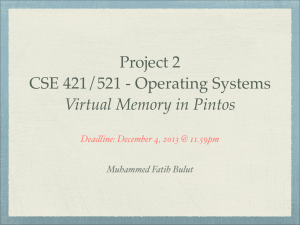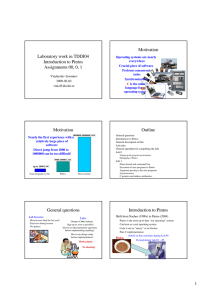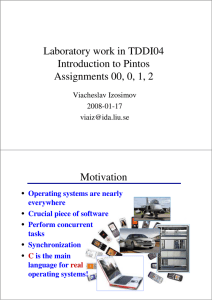Slides
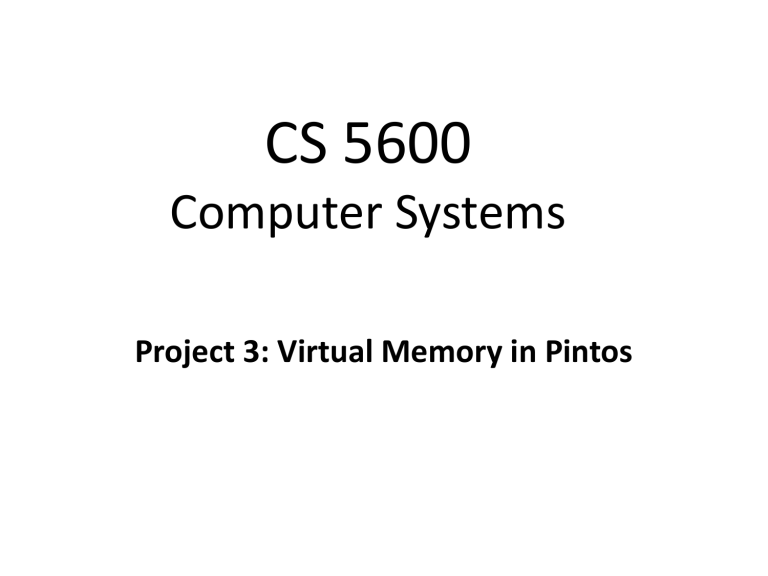
CS 5600
Computer Systems
Project 3: Virtual Memory in Pintos
Virtual Memory in Pintos
• Pintos already implements a basic virtual memory system
– Can create and manage x86 page tables
– Functions for translating virtual addresses into physical addresses
• But this system has limitations
– No support for swapping pages to disk
– No support for stack growth
– No support for memory mapping files
2
Your Goals
1. Implement page swapping
– If memory is full, take a page from physical memory and write it to disk
– Keep track of which pages have been moved to disk
– Reload pages from disk as necessary
2. Implement a frame table
– Once memory becomes full, which pages should be evicted?
3. Implement a swap table
– Maps pages evicted from memory to blocks on disk
3
Your Goals (cont.)
4. Implement stack growth
– In project 2, the stack was limited to one page
– Allow the stack to grow dynamically
5. Implement mmap() and munmap()
– i.e. the ability to memory map files
– Create a table that keeps track of which files are mapped to which pages in each process
4
What Pintos Does For You
• Basic virtual memory management
– User processes live in virtual memory, cannot access the kernel directly
– Kernel may access all memory
– Functions to create and query x68 page tables
• Trivial filesystem implementation
– You can read and write data to disk
– Thus, you can read and write memory pages
5
Utilities
• threads/pte.h
– Functions and macros for working with 32-bit x86
Page Table Entries (PTE)
• threads/vaddr.h
– Functions and macros for working with virtualized addresses
– Higher-level functionality than pte.h
– Useful for converting user space pointers into kernel space
• userprog/pagedir.c
– Implementation of x86 page tables
6
• Page fault handler: userprog/exception.c
static void page_fault ( struct intr_frame *f) { bool not_present, write, user; void *fault_addr; /* Fault address. */ asm ( "movl %%cr2, %0" : "=r" (fault_addr)); /* Obtain faulting address*/ intr_enable (); page_fault_cnt++; /* Count page faults. */
/* Determine cause. */ not_present = (f->error_code & PF_P) == 0; /* True: not-present page, false: writing r/o page. */ write = (f->error_code & PF_W) != 0; /* True: access was write, false: access was read. */ user = (f->error_code & PF_U) != 0; /* True: access by user, false: access by kernel. */
/* Code for handling swapped pages goes here! */
} printf ( "Page fault at %p: %s error %s page in %s context.\n” , …); kill (f);
7
Supplementary Page Tables
• The format of the page table is defined by the x86 standard
– You can’t modify or add to it
• Thus, you will need to define additional data structures
– Supplementary page tables
– Keep track of info for eviction policy, mapping from swapped memory pages to disk, locations of memory mapped files, etc.
8
Project 3 Is Open Ended
• The previous projects were about you extending the functionality of Pintos
• In this, you are free to implement things however you wish
– pintos/src/vm/ is basically empty
9
Key Challenges
• Choosing the right data structures
– Time and memory efficiency are critical
– Hash tables? Lists? Bitmaps?
– You don’t need to implement more exotic data structures (e.g. red-black trees)
• Handling page faults
– All swapping is triggered by page faults
– Handling them, and restarting the faulting instruction, are critical
10
More Key Challenges
• Implementing eviction
– How do you choose which page to evict?
• Detecting stack growth
– You will need to develop heuristics to determine when a process wants to grow the stack
• Managing concurrency
– Pages can be evicted at any time
– What happens if the kernel or a process is accessing them?
11
Extra Credit Challenge!
• Implementing Sharing
– What happens if a program is run >1 time?
• You could share the code pages
– What happens if >1 process mmap()s the same file?
• Worth an additional two points
– So 17 out of 15
12
Things Not To Worry About
• Your supplementary data structures may live in kernel memory
– i.e. they will never get swapped to disk
– In a real OS, page tables may be swapped to disk
13
Modified Files
•
• Makefile.build
threads/init.c
4
5
• threads/interrupt.c
2
•
• threads/thread.c
threads/thread.h
31
37
• userprog/exception.c
12
• userprog/pagedir.c
10
• userprog/process.c
319
• userprog/syscall.c
• userprog/syscall.h
545
1
Add new files
Initialize supplementary tables for the system and per thread
Modified page fault handler
Support for mmap() syscall
• vm/<new files> 628 Swapping implementation
• 11+ files changed, 1594 insertions, 104 deletions
14
Grading
• 15 (+2) points total
• To receive full credit:
– Turn in working, well documented code that compiles successfully and completes all tests (50%)
– Turn in a complete, well thought our design document (50%)
• If your code doesn’t compile or doesn’t run, you get zero credit
– Must run on the CCIS Linux machines!
• All code will be scanned by plagiarism detection software
Turning In Your Project
1. Register yourself for the grading system
$ /course/cs5600f14/bin/register-student [NUID]
2. Register your group
– All group members must run the script!
$ /course/cs5600f14/bin/register project3 [team name]
3. Run the turn-in script
– Two parameters: project name and code directory
$ /course/cs5600f14/bin/turnin project3 ~/pintos/src/
DUE: November 12
11:59:59PM EST
QUESTIONS?
17
